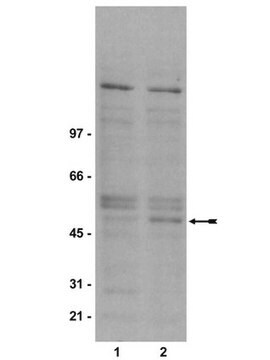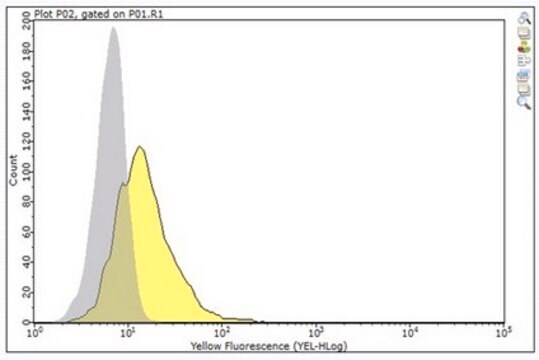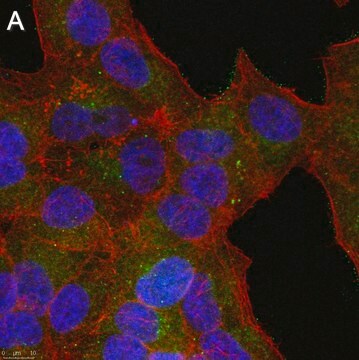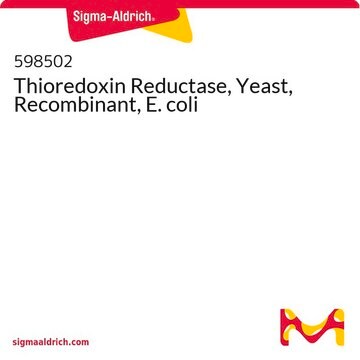05-413
Anti-phospho-GSK3 (Tyr279/Tyr216) Antibody, clone 5G-2F
clone 5G-2F, Upstate®, from mouse
Synonim(y):
GSK-3 alpha, glycogen synthase kinase 3 alpha
About This Item
Polecane produkty
pochodzenie biologiczne
mouse
Poziom jakości
forma przeciwciała
purified immunoglobulin
rodzaj przeciwciała
primary antibodies
klon
5G-2F, monoclonal
reaktywność gatunkowa
mouse, human, rat
producent / nazwa handlowa
Upstate®
metody
western blot: suitable
izotyp
IgG1κ
przydatność
not suitable for immunoprecipitation
numer dostępu NCBI
numer dostępu UniProt
Warunki transportu
dry ice
docelowa modyfikacja potranslacyjna
phosphorylation (pTyr279/pTyr216)
informacje o genach
human ... GSK3A(2931)
mouse ... Gsk3A(606496)
rat ... Gsk3A(50686)
Opis ogólny
There exists two isoforms of GSK3, alpha and beta, and they show a high degree of amino acid homology. The two isoforms of GSK3 are strictly regulated via phosphorylation. Activation of GSK3 beta is dependent upon the phosphorylation of Tyr216 (Tyr279 in GSK3 alpha). Upon activation, it has been shown to phosphorylate a number of different cellular proteins, including p53, c-Myc, c-Jun, heat shock factor 1 (HSF1), and cyclin D1
Specyficzność
Immunogen
Zastosowanie
Signaling
PI3K, Akt, & mTOR Signaling
Jakość
Western Blot Analysis:
0.5-2 µg/mL of this lot detected phospho-GSK3 in RIPA lysates from human Jurkat cells. Previous lots detected phospho-GSK3 in mouse 3T3/A31, human A431 lysates and rat L6 cells
Opis wartości docelowych
Postać fizyczna
Przechowywanie i stabilność
Handling Recommendations:
Upon receipt, and prior to removing the cap, centrifuge the vial and gently mix the solution. Aliquot into microcentrifuge tubes and store at -20ºC. Avoid repeated freeze/thaw cycles, which may damage IgG and affect product performance.
Komentarz do analizy
Positive Antigen Control: Catalog #12-303, Jurkat cell lysate.
Inne uwagi
Informacje prawne
Oświadczenie o zrzeczeniu się odpowiedzialności
Nie możesz znaleźć właściwego produktu?
Wypróbuj nasz Narzędzie selektora produktów.
Kod klasy składowania
12 - Non Combustible Liquids
Klasa zagrożenia wodnego (WGK)
WGK 1
Temperatura zapłonu (°F)
Not applicable
Temperatura zapłonu (°C)
Not applicable
Certyfikaty analizy (CoA)
Poszukaj Certyfikaty analizy (CoA), wpisując numer partii/serii produktów. Numery serii i partii można znaleźć na etykiecie produktu po słowach „seria” lub „partia”.
Masz już ten produkt?
Dokumenty związane z niedawno zakupionymi produktami zostały zamieszczone w Bibliotece dokumentów.
Nasz zespół naukowców ma doświadczenie we wszystkich obszarach badań, w tym w naukach przyrodniczych, materiałoznawstwie, syntezie chemicznej, chromatografii, analityce i wielu innych dziedzinach.
Skontaktuj się z zespołem ds. pomocy technicznej








